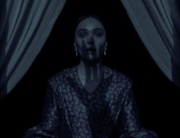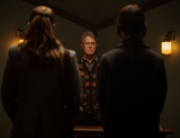It’s worth knowing beforehand that director Luca Guadagnino has taken an Italian giallo from 1977, Dario Argento’s 98-minute blood-drenched Suspiria, and has reinterpreted and made it his own, at 152 minutes. He combines Argento’s gory, supernatural intrigue of a Berlin dance company, run by a coven, with extended modern dance sequences while also offering a tribute—or a celluloid sacrifice, some might say—to European pictures of the late 1970s and early ’80s.
So it’s safe to say going into the film that it will be indulgent, and it is, and for the most part intriguingly so. To compare it to Darren Aronofsky’s ambitious but self-consciously puzzling mother! would be facile, though also apt. The remake of Suspiria arguably has more garishly disturbing and graphic images than a single movie can contain—although the result is bewildering more than horrific, despite the brutality of the onscreen violence. For those in need of a fix, the gore begins about 45 minutes into the story.
To explain what happens, plot-wise, is somewhat unnecessary: it’s not that type of movie. The audience already knows something sinister is simmering in the Markos Dance Academy thanks to the prologue, in which Patricia (Chloë Grace Moretz) arrives for her therapy appointment with a Doctor Josef Klemperer, drenched from the rain, out of breath, and fearing for her life. She tells the initially skeptical doctor that the teachers at her all-female dance school are witches and that they will “hollow me out and eat my c*** on a plate.”
Now that actress Tilda Swinton has outed herself, it’s not a spoiler to reveal that she plays Madame Blanc, the school’s head instructor, as well as the elderly, gentle Klemperer (billed as Lutz Ebersdorf), buried under convincing makeup, prosthetic penis and all. Vocally, she sounds convincingly like a man in his 70s, although he’s made up to look much older. Swinton also plays a third character, which may be harder to pick out, again thanks to the amount of prosthetics.
In the first of the narrative’s six acts, all set in 1977, a Mennonite farmer’s daughter from Ohio, the soft-spoken Susie Bannion (Dakota Johnson), also soaked from the ever-present downpour, follows her wet, fold-out map through West Berlin to the Markos Dance Academy, seeking an audition. Non-spoiler: the presumed innocent American abroad, and self-taught dancer, is readily accepted, now that there’s an opening after Patricia has vanished. In private, the sphinx-like Madame Blanc tells her colleagues that the never-seen school founder, Helena Markos, wants the new girl—but what for?
Within the dance studio, whenever a certain dance called “Volk” is performed, someone will be tortured, or worse. Movement is a form of incantation. The muscular, thrusting, punchy choreography is the antithesis of the softer, graceful movements of ballet, and the effect is intentionally confrontational and violent. (Choreographer Damien Jalet was clearly inspired by Pina Bausch, among others.) Johnson reportedly began training a year before production, though presumably she had a body double for the dance sequences; her face is hidden by a wig of long red hair, and in one number she is mostly obscured by face paint. (There’s a reason Catherine Zeta-Jones wore a bobbed wing for her dance numbers in Chicago. It was never in doubt who was actually dancing.)
Johnson may have top billing, but the film’s central character is really the members of the school’s faculty, made up of a cast that is a throwback to European films of 40 years ago, including Ingrid Caven, frequent collaborator of Rainer Werner Fassbinder (The Merchant of Four Seasons). Dutch actress Renée Soutendijk practically reprises her role as the icy blonde femme fatale from Paul Verhoeven’s The 4th Man in a scene that will also bring about a heightened sense of castration anxiety. German actress Angela Winkler (Volker Schlöndorff’s The Tin Drum) also plays one of Miss Blanc’s fawning flunkies, and Jessica Harper, the original Susie from the 1977 version (back when it was spelled “Suzy”) has a small but important role.
Among the story lines new to the original narrative are the last days of the terrorist group Baader-Meinhof, which has a member in the dance troupe. Another touches upon the Holocaust. However, these tacked-on subplots aren’t developed enough to prevent viewers from wondering if they are superfluous. In fact, they’re more used (in all meanings of the word) for background ambiance as the director emphasizes the visual and aural over plotting.
The editing is jittery and the shots are filmed from all angles, as if Guadagnino is daring you to look away, yet his film is not quite suspenseful enough to be labeled a thriller, despite its pedigree and premise. It’s startling rather than frightening. However, its weirdness is compelling, especially in the more linear first 90 minutes, during which it resembles an easy-to-solve mystery. Yet even then it’s too enigmatic to be called straightforward. In just one example, the motivations of Sylvie Testud’s silent observer, who is a member of the coven lurking in the background, remain elusive. It’s during the last, muddled half hour that the film’s inner logic regarding the witches’ private, sealed-off world derails and goes off on its own, and where the film will be particularly divisive among viewers as the sinister comes across as silly.
Guadagnino has made less a riddle and more of a performance art piece, with a touch of louche elegance. And because the film is initially introduced as having a prologue, six acts, and an epilogue, the audience is always aware of the countdown toward the finish line, thanks to the chapter breaks. Sparse on humor, the movie may come across as a pretentious ode to the past, but that said, there’s currently no other movie in theaters like it. The new Suspiria doesn’t try to make sense or win you over, and it’s certainly not predictable, even if you have seen the original film. Enter at your own risk, and once you do, throw caution to the wind.
Directed by Luca Guadagnino
Written by David Kajganich, based on the 1977 screenplay by Dario Argento and Daria Nicolodi
Released by Amazon Studios
Italy/USA. 152 min. Rated R
With Dakota Johnson, Tilda Swinton, Ingrid Caven, Renée Soutendijk, Angela Winkler, Mia Goth, Sylvie Testud, and Chloë Grace Moretz

















Leave A Comment